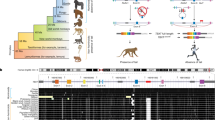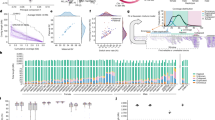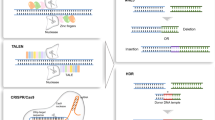Abstract
Hereditary haemorrhagic telangiectasia, or Osler–Rendu–Weber (ORW) syndrome, is an autosomal dominant vascular dysplasia. So far, two loci have been demonstrated for ORW. Linkage studies established an ORW locus at chromosome 9q3; endoglin was subsequently identified as the ORW1 gene. A second locus, designated ORW2, was mapped to chromosome 12. Here we report a new 4 cM interval for ORW2 that does not overlap with any previously defined. A 1.38–Mb YAC contig spans the entire interval. It includes the activin receptor like kinase 1 gene (ACVRLK1 or ALKI), a member of the serine–threonine kinase receptor family expressed in endothelium. We report three mutations in the coding sequence of the ALK1 gene in those families which show linkage of the ORW phenotype to chromosome 12. Our data suggest a critical role for ALK1 in the control of blood vessel development or repair.
This is a preview of subscription content, access via your institution
Access options
Subscribe to this journal
Receive 12 print issues and online access
$209.00 per year
only $17.42 per issue
Buy this article
- Purchase on Springer Link
- Instant access to full article PDF
Prices may be subject to local taxes which are calculated during checkout
Similar content being viewed by others
References
Guttmacher, A.E., McKinnon, W.C. & Upton, M.D. Hereditary hemorrhagic telangiectasia: a disorder in search of the genetics community. Am. J. Med. Genet. 52, 252–253 (1994).
Guttmacher, A.E., Marchuk, D.A. & White, R.I. Current concepts: Hereditary hemorrhagic telangiectasia. New Engl. J. Med. 333, 918–924 (1995).
McDonald, M.T. et al. A disease locus for hereditary haemorrhagic telangiectasia maps to chromosome 9q33-34. Nature Genet. 6, 197–204 (1994).
Shovlin, C.L. et al. A gene for hereditary haemorrhagic telangiectasia maps to chromosome 9q3. Nature Genet. 6, 205–209 (1994).
McAllister, K.A. et al. Endoglin, a TGF-β binding protein of endothelial cells, is the gene for hereditary haemorrhagic telangiectasia type 1. Nature Genet. 8, 345–351 (1994).
Gougos, A. & Letarte, M. Primary structure of endoglin, an RGD-containing glycoprotein of human endothelial cells. J. Biol. Chem. 265, 8361–8364 (1990).
Cheifetz, S. et al. Endoglin is a component of the transforming growth factor-β receptor system in human endothelial cells. J. Biol. Chem. 267, 19027–19030 (1992).
McAllister, K.A. et al. Six novel mutations in the endoglin gene in hereditary hemorrhagic telangiectasia type 1 suggest a dominant-negative effect of receptor function. Hum. Mol. Genet. 4, 1983–1985 (1995).
McAllister, K.A. et al. Genetic heterogeneity in hereditary hemorrhagic telangiectasia: possible correlation with clinical phenotype. J. Med. Genet. 31, 927–932 (1994).
Porteous, M.E.M. et al. Genetic heterogeneity in hereditary haemorrhagic telangiectasia. J. Med. Genet. 31, 925–926 (1994).
Heutink, P. et al. Linkage of hereditary hemorrhagic telangiectasia to chromosome 9q34 and evidence for locus heterogeneity. J. Med. Genet. 31, 933–936 (1994).
Berg, J.N., Guttmacher, A.E., Marchuk, D.A. & Porteous, M.E.M. Clinical heterogeneity in hereditary haemorrhagic telangiectasia: are pulmonary arteriovenous malformations more common in families linked to endoglin? J. Med. Genet. 33, 256–257 (1996).
Vincent, P. et al. A third locus for hereditary haemorrhagic telangiectasia maps to chromosome 12q. Hum. Mol. Genet. 4, 945–949 (1995).
Johnson, D.W. et al. A second locus for hereditary hemorrhagic telangiectasia maps to chromosome 12. Genome Res. 5, 21–28 (1995).
Attisano, L. et al. Identification of human activin and TGF-β type I receptors that form heteromeric kinase complexes with type II receptors. Cell. 75, 671–680 (1993).
ten Dijke, P. et al. Serine/threonine kinase receptors. Prog. Growth Factor Res. 5, 55–72 (1994).
ten Dijke, P. et al. Characterization of type I receptors for transforming growth factor-b and activin. Science. 264, 101–104 (1994).
Miyazono, K., ten Dijke, P., Yamashita, H. & Heldin, C.-H., Signal transduction via serine/threonine kinase receptors. Semin. Cell Bio. 5, 389–398 (1994).
Mathews, L.S. Activin receptors and cellular signaling by the receptor serine kinase family. Endocrine Rev. 15, 310–325 (1994).
Gyapay, G. et al. The 1993–94 Genethon human genetic linkage map. Nature Genet. 7, 246–339 (1994).
Kucherlapati, R., Craig, I. & Marynen, P. Report of the second international workshop on human chromosome 12 mapping 1994. Cytogenet. Cell Genet. 67, 246–264 (1994).
Carcamo, J. et al. Type I receptors specify growth-inhibitory and transcriptional responses to transforming growth factor β and activin. Mol. Cell. Biol. 14, 3810–3821 (1994).
ten Dijke, P. et al. Activin receptor-like kinases: a novel subclass of cell-surface receptors with predicted serine/threonine kinase activity. Oncogene. 8, 2879–2887 (1993).
Hanks, S.K. & Hunter, T. The eukaryotic protein kinase superfamily: kinase (catalytic) domain structure and classification. FASEB J. 9, 576–596 (1995).
Choi, M.E. & Ballermann, B.J. Inhibition of capillary morphogenesis and associated apoptosis by dominant negative mutant transforming growth factor-β receptors. J. Biol. Chem. 270, 21144–21150 (1995).
Lopez-Casillas, F., Wrana, J.L. & Massague, J. Betaglycan presents ligand to the TGF-β signaling receptor. Cell. 73, 1435–1444 (1993).
Madri, J.A. et al. Interactions of matrix components and soluble factors in vascular responses to injury. Modulation of cell phenotype. In Endothelial cell dysfunctions(eds Simionescu, N. & Simionescu, M.) (Plenum Press, New York, 1992).
Luscinkas, F.W. & Lawler, J. Integrins as dynamics regulators of vascular function. FASEB J. 8, 929–938 (1994).
Krauter, K. et al. A second-generation YAC contig map of human chromosome 12. Nature. 377, 321–333 (1995).
Struewing, J.P. et al. The carrier frequency of the BRCA1 185delAG mutation is approximately 1 percent in Ashkenazi Jewish individuals. Nature Genet. 11, 198–200 (1995).
Franzen, P. et al. Cloning of a TGF-β type I receptor that forms a heteromeric complex with the TGF-β type II receptor. Cell. 75, 681–692 (1993).
Wrana, J.L. et al. Two distinct transmembrane serine/threonine kinases from Drosophila melanogaster form an activin receptor complex. Mol. Cell. Biol. 14, 944–950 (1994).
Xie, T., Finelli, A.L. & Padgett, R.W., Drosophila saxophone gene encodes a serine-threonine kinase receptor of the TGF-β superfamily. Science. 263, 1756–1759 (1994).
Brummel, T.J. et al. Characterization and relationship of Dpp receptors encoded by the saxophone and thick veins genes in Drosophila. Cell. 78, 251–261 (1994).
Wrana, J.L. et al. Mechanism of activation of the TGF-β receptor. Nature. 370, 341–347 (1994).
Author information
Authors and Affiliations
Rights and permissions
About this article
Cite this article
Johnson, D., Berg, J., Baldwin, M. et al. Mutations in the activin receptor–like kinase 1 gene in hereditary haemorrhagic telangiectasia type 2. Nat Genet 13, 189–195 (1996). https://doi.org/10.1038/ng0696-189
Received:
Accepted:
Issue Date:
DOI: https://doi.org/10.1038/ng0696-189
This article is cited by
-
Genetics of brain arteriovenous malformations and cerebral cavernous malformations
Journal of Human Genetics (2023)
-
Bioinformatics Analysis of the Genetic and Epigenetic Alterations of Bone Morphogenetic Protein Receptors in Metastatic Breast Cancer
Biochemical Genetics (2023)
-
ALK1 Deficiency Impairs the Wound-Healing Process and Increases Mortality in Murine Model of Myocardial Infarction
Journal of Cardiovascular Translational Research (2023)
-
BMP10 functions independently from BMP9 for the development of a proper arteriovenous network
Angiogenesis (2023)
-
Spontaneous thrombosis of high flow pediatric arteriovenous fistulae: Case series of two patients and a comprehensive literature review
Child's Nervous System (2023)



